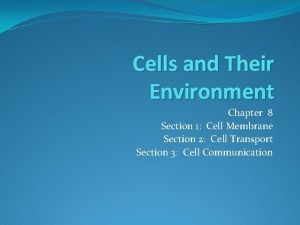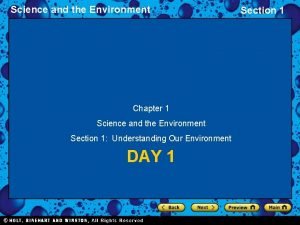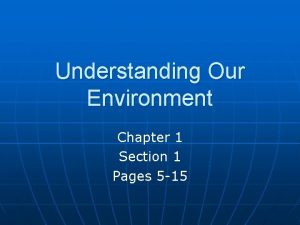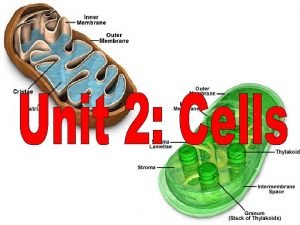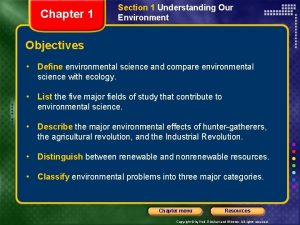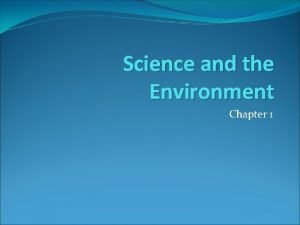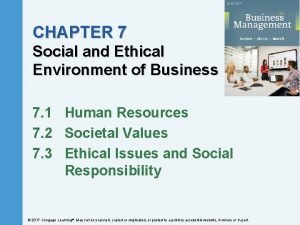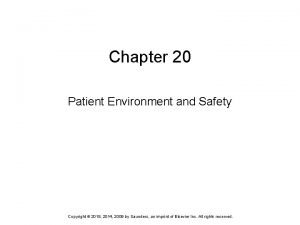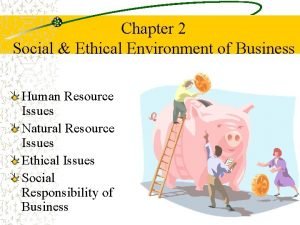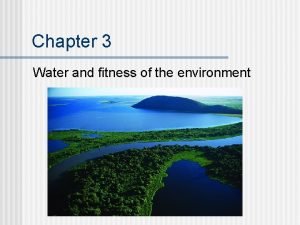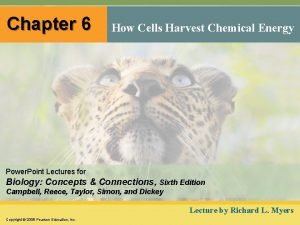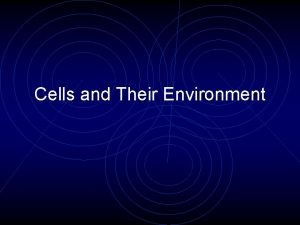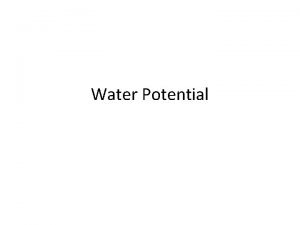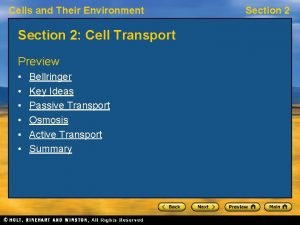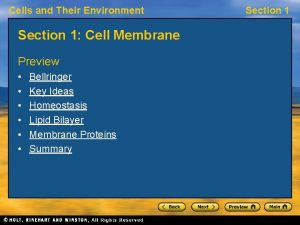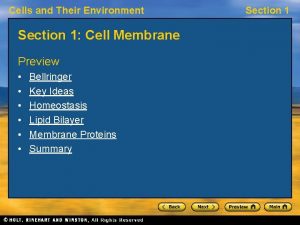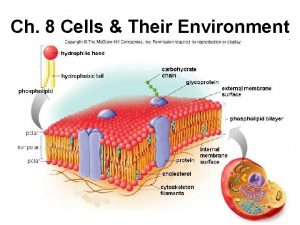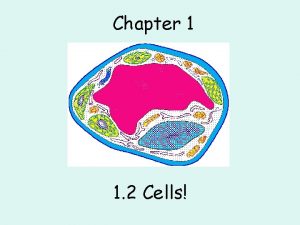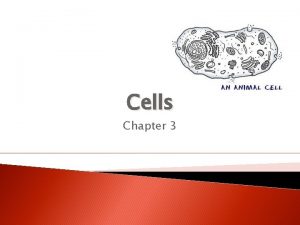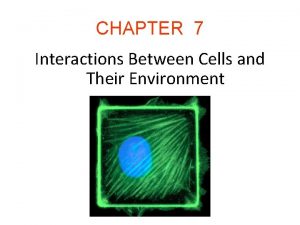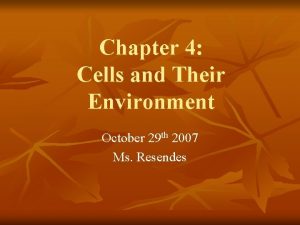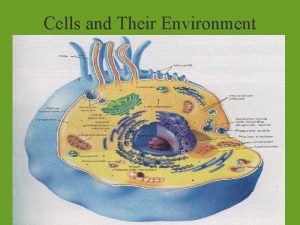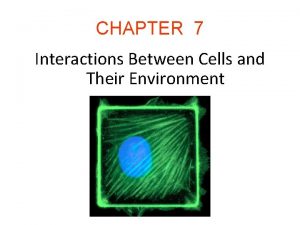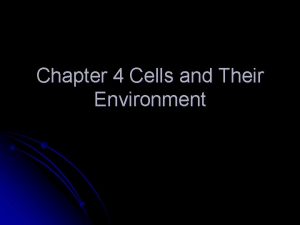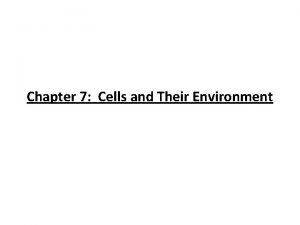Cells and Their Environment Chapter 8 Section 1






















































- Slides: 54

Cells and Their Environment Chapter 8 Section 1: Cell Membrane Section 2: Cell Transport Section 3: Cell Communication

Cell Membrane �Why it Matters A simple defect in a cell membrane protein can make a life-or-death difference. In people who have cystic fibrosis, the cell membrane does not work properly. Every cell is surrounded by a cell membrane. The membrane protects the cell and helps move substances and messages in and out of the cell. By regulating transport, the membrane helps the cell maintain constancy and order.

Homeostasis �All living things respond to their environment. �Individual cells as well as organisms, must maintain homeostasis in order to live. �How do we maintain homeostasis? �We sweat when we are hot and shiver when we are cold.

�One way that a cell maintains homeostasis is by controlling the movement of a substance across the cell membrane

�Cells are suspended in a fluid environment. Even the cell membrane is fluid. �It is made up of lipids in which proteins float. �It allows some materials in, but not others. The cell membrane is the gate keeper.

�It also provides structural support to the cytoplasm, recognizes foreign material, and communicates with other cells. �These functions also contribute to maintaining homeostasis.

Lipid Bilayer �The cell membrane is made of phospholipids. �Phospholipid is a specialized lipid made of a phosphate “head” and two fatty acid “tails”

�The phosphate head is polar and is attracted to water whereas the fatty acid tails are nonpolar and are repelled by water. �Phospholipid--a lipid that contain phosphorus and that is a structural component in cell membrane.

Structure Because there is water on the inside and the outside of the cell, the phospholipids form a double layer called the lipid bilayer. • Lipid bilayer--the basic structure of a biological membrane, composed of two layers of phospholipids. • The polar heads are attracted to water, so they point toward the surfaces of the lipid bilayer. One layer of the polar heads faces the cytoplasm whole the other layer is in contact with the cell’s immediate surrounding.

�The nonpolar tails, repelled by water make up the interior of the lipid bilayer.

Barrier Only certain substances can pass through the lipid bilayer. Ø The phospholipids form a barrier through which only small, nonpolar substances can pass. Ø Ions and most polar molecules are repelled by the nonpolar interior of the lipid bilayer.

Membrane Proteins �There are many various proteins that can be found in the cell membrane. Some proteins face inside the cell, and some face outside the cell. Still others may stretch across the lipid bilayer and face both sides.

�Proteins in Lipids �Remember proteins are made of amino acids. Some amino acids are polar and others are nonpolar. �So nonpolar proteins are attracted to the interior of the lipid layer, but are repelled by water on either side of the membrane. �Polar parts of the protein are attracted to the water on both sides of the lipid bilayer. �These opposing attractions help hold the protein in the membrane.

�Types of Proteins �Proteins in the cell membrane include the cellsurface markers, receptor proteins, enzymes, and transport proteins. �Cell-Surface Markers--Like a name tag, a chain of sugars acts as a marker to identify each type of cell. �Example: liver cells have a different chain of sugars from heart cells. These sugars (carbohydrates) are attracted to the cells surface by proteins called glycoprotein's. Glycoprotein helps the cells work together.

�Receptor Proteins--Receptor proteins enable a cell to sense its surroundings by binding to certain substances outside the cell. When this happens, it causes changes inside the cell. �Enzymes--Many proteins in the cell membrane help with important biochemical reactions inside the cell. �Transport Proteins—Many substances that the cell needs cannot pass through the. lipid bilayer. Transport proteins aid the movement of these substances into and out of the cell.


�What are some roles of the cell membrane? �The cell membrane provides structural support to the cytoplasm, recognizes foreign material, communicates with other cells, and helps transport substances. �Why can’t ions pass through the lipid bilayer? �Small, nonpolar molecules, ions, and most polar molecules are repelled by the nonpolar interior of the lipid bilayer.

Cell Transport �Section 2 Why It Matters The cell’s membrane is a little like a country’s border. Both barriers regulate who or what enters and who or what leaves.

�The cell must move substances of varying size, electric charge and composition into and out of the cell. Substances may enter and leave the cell in a variety of ways. Sometime the cell must use energy to move a substance across the cell membrane. In active transport the cell is required to use energy to move a substance. In passive transport, the cell does not use energy.


Passive Transport �In a solution, randomly moving molecules tend to fill up a space. When the space is filled evenly, a state called equilibrium is reached. �The amount of a particular substance is a given volume is called the concentration of the substance. �When one area has a higher concentration than another area does, a concentration gradient exists. �Substances move from an area of higher concentration to an area of lower concentration.

�This movement down the concentration gradient is called diffusion. �The cell membrane separates the cytoplasm from the fluid outside the cell. �The direction of movement depends on the concentration gradient and does not require energy.

�In passive transport, substances cross the cell membrane down their concentration gradient. �Equilibrium--a state that exist when the concentration of a substance is the same throughout a space. �Concentration gradient--a difference in the concentration of a substance across a distance. �Diffusion--the movement of particles from regions of higher density to regions of lower density.

�Simple diffusion �Small nonpolar molecules can pass directly through the lipid bilayers. This type of movement is called simple diffusion. �Oxygen and carbon dioxide diffuse in and out of the cell. �Natural steroid hormones, which are nonpolar and fat soluble, can also diffuse across the lipid bilayer.


�Facilitated Diffusion �Many ions and polar molecules that are important for cell function do not diffuse easily through the nonpolar lipid bilayers. During facilitated diffusion, transport proteins help these substances diffuse through the cell membrane. Two types of transport proteins are channel proteins and carrier proteins.

�Channel Proteins—ions, sugars, and amino acids can diffuse through the cell membrane through channel proteins. �These proteins are sometimes called pores serve as a tunnel through the lipid bilayer. �Each channel allows the diffusion of specific substances that have the right size and charge.

�Carrier Proteins--transport substances that fit within their binding site. A carrier protein binds to a specific substance on one side of the cell membrane. This binding causes the protein to change shape. As the protein’s shape changes, the substance is moved across the membrane and is released on the other side.

Osmosis �Water can diffuse across a selectively permeable membrane in a process called osmosis. �Osmosis allows cells to maintain water balance as their environment changes. �Osmosis occurs as free water molecules move down their concentration gradient into the solution that has the lower concentration of free water molecules.


�Water channels--polar molecules do not diffuse directly through the bilayers. But the cell membrane contains channel proteins that only water molecules can pass through. �Osmosis in cells is a form of facilitated diffusion. �In humans water channels help in the regulation of body temperature, in digestion, in reproduction, and in water conservation in the kidneys.

�Predicting Water Movement �The direction of water movement in a cell depends on concentration of the cell’s environment. � 1. Water moves out. If the solution is hypertonic, or has a higher solute concentration that the cytoplasm does, water moves out of the cell. The cell loses water and shrinks. � 2. Water moves in. If the solution is hypotonic, or has a lower solute concentration that the cytoplasm does, water moves into the cell. The cell gains water and expands in size.

� 3. No net change in water movement occurs or equilibrium is reached. If the solution is isotonic, or has the same solute concentration that the cytoplasm does, water diffuses into and out of the cell at equal rates. The cell stays the same size.


�Effects of osmosis �Swelling caused by a hypotonic solution could cause a cell to burst. �The rigid cell walls of plants and fungi prevent these organisms from expanding too much. �Many plants are healthiest in a hypotonic environment. �Unicellular eukaryotes have contractile vacuoles that collect the excess water. �Animal cells avoid swelling by actively removing solutes from the cytoplasm. This increases the concentration of free water molecules inside the cell.

�Osmosis--the diffusion of water or another solvent from a more dilute solution (of a solute) to a more concentrated solution (of the solute) through a membrane that is permeable to the solvent. �Word parts: the prefix hyper- means “higher than, ” and hypertonic means “higher concentration. ” If hypo - means “lower than, ” this means hypotonic means “lower concentration. ”

Active Transport �Cells must sometimes move substances across their concentration gradient and this requires energy. This is called active transport. �Active transport requires energy to move substances against their concentration gradients. �This energy supplied for active transport whether directly or indirectly by ATP.

�Pumps—many active transport proteins use carrier proteins to move substances. In active transport, the carrier proteins do require energy to “pump” substances against their concentration gradient. �One of the most important carrier proteins in animal cells is the sodium-potassium pump. �The pump prevents sodium ions from building up in the cell. �Osmosis results when sodium ion levels are high. �The concentration gradients of sodium ions and potassium also help transport other substances, such as glucose, across the cell membrane.

�So how does the sodium-potassium pump Sodium ions inside the cell bind to the carrier protein. A phosphate group from ATP transfers energy to the protein. The protein changes shape and releases the sodium ions outside the cell membrane. Outside the cell, potassium bind to the pump. As a result, the phosphate group is released from the pump. The pump returns to its original shape and releases the potassium ions inside the cell membrane. For every three sodium ions taken out, two potassium ions are brought inside.

�Vesicles--many substances such as proteins and polysaccharides, are too large to be transported by carrier proteins. Instead the cross the cell membrane in vesicles. �The movement of a large substance into a cell by means of a vehicle is called endocytosis. �The movement of material out of a cell by means of a vesicle is called exocytosis


Cell Communication Section 3 Why It Matters Cells developed sophisticated methods of communication long before humans developed the internet, cell phones, or even regular conversation. Cells in multicellular organisms depend on the activities of other cells to survive. Even unicellular organisms need to communicate—for example in finding a mate.

Sending Signals �Cells use various methods to communication. These on methods vary depending whether the target is specific or general. They also depend on whether the target is nearby or far away. �Cells communicate and coordinate activity by sending chemical signals that carry information to other cells.

�A signaling cell produces a signal, often a molecule, that is detected by the target cell. Typically, target cells have specific proteins that recognize and respond to the signal. �Signal--anything that serves to direct, guide, or warn.

�Targets �Neighboring cells can communicate through direct contact between their membranes. �Short distance signals may act locally, a few cells away from the originating cell. �Long distance signals are carried by hormones and nerve cells.

�Hormones are signal molecules made in one part of the body. They are distributed widely in the blood stream throughout the body, but they affect only specific cells. �Nerve cells also signal information to distant locations in the body, but their signals are not widely distributed.

�Environmental Signals �Some signals come from outside. �Example: light has great effect on the action of hormones in plants. The length of the day determines when some plants flower.

Receiving Signals �Target cells are bombarded with hundreds of signals. But it recognizes and responds only to the few signals that are important for its function. �The response to some signals, but not to others, is made possible by receptor proteins, such as the one’s in the cell’s membrane. �Receptor proteins--a protein that binds specific signal molecules, which causes the cell to respond.

�Binding specificity �A receptor protein binds specific substance, such as signal molecules. The outer part of the protein is folded into a unique shape called a binding site. � A receptor protein binds only to signals that match the specific shape if its binding site. �Effect �Once it binds the signal molecule, the receptor protein changes its shape in the membrane. This change in shape relays information into the cytoplasm of the target cell.


Responding to Signals �When a signal molecule binds to a receptor protein, the protein changes shape, which triggers changes in the cell membrane. �The cell may respond to a signal by changing its membrane permeability, by activating enzymes, or by forming a second messenger.

�Permeability Change—Transport proteins may open or close in response to a signal. �Enzyme Activation—Some receptor proteins activate enzymes in the cell membrane. Some receptors are enzymes themselves and are activated by the binding acts of a signal molecule. Enzymes triggers chemical reactions in the cell. �Second Messenger—Binding of a signal molecule outside the cell may cause a second messenger to form. The second messenger acts as a signal molecule within the cell and causes changes in the cytoplasm and nucleus.

�Second messenger—a molecule that is generated when a specific substance attaches to a receptor on the outside of a cell membrane, which produces a change in cellular function.

Questions �Compare the targets of signaling hormones and nerve cells. �Both signals have long-distance targets. Hormones are distributed widely but affect only certain cells; nerve cells’ signals are not widely distributed and instead affect cells in certain locations. �How does membrane permeability change? �Transport proteins open and close in response to signals.
 Cells and their environment worksheet answers
Cells and their environment worksheet answers Nondisjunction in meiosis
Nondisjunction in meiosis Submentovertical projection
Submentovertical projection Chlorocruorin
Chlorocruorin Plant cell vs animal cell venn diagram
Plant cell vs animal cell venn diagram Masses of cells form and steal nutrients from healthy cells
Masses of cells form and steal nutrients from healthy cells Chapter 1 science and the environment section 2
Chapter 1 science and the environment section 2 Transport maximum
Transport maximum Parafollicular
Parafollicular Somatic vs gamete
Somatic vs gamete Why dna is more stable than rna?
Why dna is more stable than rna? Prokaryotic cells vs eukaryotic cells
Prokaryotic cells vs eukaryotic cells Prokaryotic vs eukaryotic cells venn diagram
Prokaryotic vs eukaryotic cells venn diagram The organelle trail
The organelle trail Pseudostratified vs simple columnar
Pseudostratified vs simple columnar Cuál es la diferencia entre la célula animal y vegetal
Cuál es la diferencia entre la célula animal y vegetal Which organisms are prokaryotes
Which organisms are prokaryotes Cell substance
Cell substance Chapter 26 section 1 arthropod characteristics answer key
Chapter 26 section 1 arthropod characteristics answer key Chapter 2 principles of ecology
Chapter 2 principles of ecology Principles of ecology chapter 2 section 1 answer key
Principles of ecology chapter 2 section 1 answer key Chapter 2 principles of ecology test answers
Chapter 2 principles of ecology test answers Chapter 2 principles of ecology answer key
Chapter 2 principles of ecology answer key Chapter 2 section 1 organisms and their relationships
Chapter 2 section 1 organisms and their relationships Chapter 1 section 1 understanding our environment answers
Chapter 1 section 1 understanding our environment answers Environment of business finance
Environment of business finance How do arctic wolves adapt to their environment
How do arctic wolves adapt to their environment Anasazi achievements
Anasazi achievements Which represents an aztec adaptation to their environment
Which represents an aztec adaptation to their environment Chapter 10 meiosis 1 and meiosis 2
Chapter 10 meiosis 1 and meiosis 2 Section 1 organisms and their relationships
Section 1 organisms and their relationships Overview elements and their properties answer key
Overview elements and their properties answer key Chapter 17 section 3 mixed groups
Chapter 17 section 3 mixed groups Elements and their properties section 1 metals
Elements and their properties section 1 metals Romeo and juliet prologue modern translation
Romeo and juliet prologue modern translation Body tissues chapter 3 cells and tissues
Body tissues chapter 3 cells and tissues Body tissues chapter 3 cells and tissues
Body tissues chapter 3 cells and tissues Which part of the cell contains genetic material
Which part of the cell contains genetic material Cell membrane phospholipids
Cell membrane phospholipids Body tissues chapter 3 cells and tissues
Body tissues chapter 3 cells and tissues Chapter 3 cells and tissues figure 3-1
Chapter 3 cells and tissues figure 3-1 Anatomy chapter 3 cells and tissues
Anatomy chapter 3 cells and tissues Chapter 4 cells and energy
Chapter 4 cells and energy Section 1 understanding our environment answer key
Section 1 understanding our environment answer key Chapter 1 science and the environment answer key
Chapter 1 science and the environment answer key Chapter 1 science and the environment
Chapter 1 science and the environment Chapter 2 social and ethical environment of business
Chapter 2 social and ethical environment of business Chapter 7 social and ethical environment of business
Chapter 7 social and ethical environment of business Chapter 20 patient environment and safety
Chapter 20 patient environment and safety Chapter 2 social and ethical environment of business
Chapter 2 social and ethical environment of business Chapter 3 water and the fitness of the environment
Chapter 3 water and the fitness of the environment Half section views
Half section views Work and energy section 2 describing energy answer key
Work and energy section 2 describing energy answer key Chapter 6 how cells harvest chemical energy
Chapter 6 how cells harvest chemical energy How cells harvest chemical energy chapter 6
How cells harvest chemical energy chapter 6
